
There’s a story behind every name, and White Bear Lake is no different.
The city of lakes and legends is built on a network of stories, each one as important as the last. It’s the larger theme behind an initiative to bring the legend of White Bear Lake to the broader public.
White Bear Center for the Arts (WBCA) has earned support from Big Read, an initiative created by the National Endowment for the Arts (NEA) in partnership with Arts Midwest, to encourage programming about the legend of White Bear Lake. With the help of a $17,900 grant from NEA, the initiative seeks to increase understanding of the world through a shared reading experience.
“[The project] supports organizations to create quality programming that is centered around the premise of the chosen book,” says Karen Parkman, WBCA outreach coordinator. “It brings the community together around this one literary work and creates programs and experiences that build on its themes.”
The books that are chosen for each of these projects act as a starting point to spark conversation and encourage educational growth through community programming made accessible by the grantees.
WBCA’s chosen novel is The Bear, written by National Book Award in Fiction finalist Andrew Krivak. The story is a coming-to-age fable that follows a father and daughter as they navigate the world as the last two human inhabitants. Using the secrets of the seasons (passed down for generations), the father teaches his daughter how to survive and live in harmony with the wild. When she finds herself lost in the wilderness, it is a bear that leads her home to safety.
“It is about the relationship with the natural environment we live in and how it shapes who we are,” Parkman says, adding that it was the book’s potential to inspire “rich conversation” that led to WBCA’s decision. “[The book can] help us … think more about the stories that make us who we are and inspire us to feel more connected to the local environment.”
Parkman says the book also touches on how cultural practices are passed down through generations—a theme consistent with the program’s focus on the Native oral history of the legend of White Bear Lake.
“Now more than ever there is an attention on history and how did we get here, what happened in the past or how have we evolved,” says Sara Hanson, the executive director of the White Bear Lake Area Historical Society.
To ensure these conversations are accessible to a larger demographic, WBCA will be working with other community partners and organizations, including the White Bear Lake Area Historical Society, Ramsey County Library, Mahtomedi Community Education, Gable Pines at Vadnais Heights, Century College Library and the Bell Museum’s Whitney and Elizabeth MacMillan Planetarium.
The involvement of these organizations will also provide community members with the opportunity to get involved in a way that speaks to them, whether through art, conversation or observation.
“Art is essential and the best tool we have to express our experiences and learn more about others,” says Parkman.
The Legend
The naming of White Bear Lake and Manitou (“Great Spirit”) Island is itself a tribute to the Native legend said to have taken place there.
“It is said that a Sioux maiden fell in love with a Chippewa brave. She, the daughter of the Chief, on learning that her father planned war against the Chippewa, ran to her lover and warned him. The brave went alone into the Sioux village to ask for peace and the hand of the maiden. Before the Chief would agree, the Chippewa would have to do a brave deed.
“The lovers usually met on Manitou Island. One day, as the brave approached the Island, anticipating a meeting with his beloved, he saw, to his horror, a great white bear attacking her. He dashed to her rescue. Freed, she ran to get help from her father and the other Sioux. Returning, they saw the brave sink his knife into the bear. But too late, they both fell to the ground dead. Slowly, as they watched, the spirits of the brave and the bear rose from their prone bodies. It is said that even today, as night falls, the spirits of the bear and the brave wander the Island eternally in search of each other.” (From the book Indian Legends of Minnesota by Mrs. Carl T. Thayer, J.R. Osgood & Co., 1883, pages 583–593.)
This excerpt is, in itself, a retelling, perhaps inspired in parts by local legend and the influence of new visitors and cultures. Another popular rendition can be found quoted in the pages Mark Twain’s novel Life on the Mississippi. Twain’s version of the forbidden love story also follows the path of a man and a woman from opposing tribes. The man saves his love by slashing the bear with his knife. By killing the “monster,” both sides are brought together, allowing the couple and their tribes to live harmoniously together.
“Their children for many years played upon the skin of the white bear—from which the lake derives its name, and the maiden and the brave remembered long the fearful scene and rescue that made them one …” (Quoted by Mark Twain in Life on the Mississippi 1883, page 399.)
And while these are just two of the many versions of this story, spread near and far, Hanson remarks on the validity of each in their representation of changing perspectives through the generations. “As a historian I like physical evidence and documentation, but as storytelling piece and a human element, the legend is fascinating to me,” she says.
The Legend Comes to Life
After hearing about the legend from a friend, Minneapolis-born writer and composer Caroline Wigmore knew she wanted to bring the rich history of White Bear Lake to life in a new way. Now, young performers find themselves sharing a version of the story on stage far from the legend’s origins—in Plymouth, England.
“When translating to the stage you are not necessarily going to produce a word-for-word documentary style story, you are working to tell the emotional truth to the story,” she says about their adaptation, titled The Legend of White Bear Lake.
With the legend as the backbone of the story, Wigmore’s company, Wigmore & Green, made a few alterations to the modern Romeo and Juliet story. The main characters in this version are young animals from feuding tribes. And the tragic ending becomes one of hope when the protagonists find harmony following a period of war and the wrath of the “terrifying white bear.”
“It is a story about two people that are at odds with each other and they need to make peace with each other but don’t know how … a magical story that still holds true for us now,” Wigmore says. “In a time when there is so much civil unrest … it is a story about two teenagers that break through that barrier and find someone who is like themselves.”
For more information about this show and other projects visit wigmoreangreen.com.
A Polar Bear or … Not?
As I was working on this story, I stumbled across the Kermode bear, sometimes called the “spirit bear.” This subspecies of the North American black bear has a rare recessive gene that gives them white fur—it’s also a symbol of change for Indigenous peoples. Though these rare bears are now found primarily in British Columbia (where there are as few as 100 Kermode bears), one was spotted in Michigan this autumn—the first to be seen outside of British Columbia since 2004. It could be coincidence, these white spirit bears and the story of Manitou (“Great Spirit”) Island, but it’s never too late for new legends to be made.

Programming Available
The WBCA will be utilizing its creative resources to offer reduced tuition art classes, lectures and hands-on workshops that draw themes from the book, including winter traditions, drawing in nature, finding inspiration from trees and more.
The White Bear Lake Area Historical Society will provide a three-part talking series in collaboration with David Mather, National Register archeologist at the Minnesota State Historic Preservation Office, throughout the month of November. The first session focuses on bear ceremonialism and the use of bears spiritually and symbolically. The second session discusses how bears appear ceremonially in archeology throughout Minnesota. The last part to the series will explore our local connection to bears and their symbolism, including the variations of the legend of White Bear Lake.
From the Author
“By calling the novel The Bear, I am suggesting that there is hope all around us, if we step back and see ourselves as part of—not the center of—a larger, ever more beautiful and animate world. I hope readers will see and hold on to both the beauty and the struggle. Look around. There is struggle everywhere. But there is also beauty.” —Andrew, Krivak, a personal note on writing The Bear

Check out NEA Big Read classes and programs happening this month:
Lecture Series with David Mather
11/07, 11/14
This series, organized by the historical society, will look into bear ceremonialism from a local, statewide and global perspective. All ages. Free. 7–8 p.m. White Bear Lake Area Historical Society, 2228 Fourth St.; whitebeararts.org
NEA Big Read Book Discussion
11/17
Join your community for an in-depth discussion of The Bear, facilitated by WBCA.
All ages. Free. 2–3:30 p.m. Gable Pines at Vadnais Heights, 1260 County Road E East, St. Paul; whitebeararts.org
The Legends of White Bear Lake
11/28
The White Bear Lake Area Historical Society explores the origin and evolution of the legends of White Bear Lake. All ages. Free. 6 p.m. White Bear Lake Area Historical Society, 2228 Fourth St.; whitebeararts.org
White Bear Center for the Arts,
4971 Long Ave.; 651.407.0597;
whitebeararts.org
White Bear Center for the Arts
@whitebearcenterforthearts
White Bear Lake Area Historical Society;
2228 Fourth St.; 651.407.5327;
whitebearhistory.org
White Bear Lake Area History Society
@whitebearhistory









